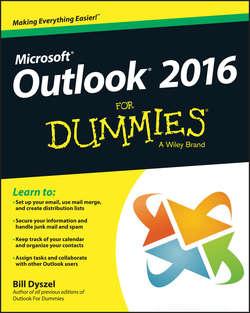Читать книгу Outlook 2016 For Dummies - Dyszel Bill - Страница 14
На сайте Литреса книга снята с продажи.
Part I
Getting Started With Outlook 2016
Chapter 1
Outlook Features You Really Need to Know
Maintaining Your Calendar
ОглавлениеTime management is a myth. You can’t get more than 24 hours in a day – no matter how well you manage it. But you can get more done in a 24-hour day if you keep your calendar current. Outlook can help you with that.
Entering an appointment
If you’ve ever used an old-fashioned paper planner, the Outlook Calendar will look familiar to you. When you click the Calendar button and then click the Day tab, you see a grid in the middle of the screen with lines representing each segment of the day. You can adjust the length of the segments from as little as five minutes to as much as an hour, as shown in Figure 1-3.
Figure 1-3: Track your busy schedule in the Outlook Calendar.
To enter an appointment at a certain time, follow these steps:
1. Click the line next to the time you want your appointment to begin.
2. Type a name for your appointment.
3. Press Enter.
If you want to enter more detailed information about your appointment – such as ending time, location, category, and so on – see Chapter 8 for the nitty-gritty on keeping track of all the details in your calendar.
Managing your schedule
Time management involves more than just entering appointments. If you’re really busy, you want to manage your time by slicing and dicing your list of appointments to see when you’re free to add even more appointments.
You can choose from several different views of your calendar by clicking a button at the top of the Calendar screen:
✔ Day
✔ Work Week
✔ Week
✔ Month
✔ Schedule
If you need a more elaborate collection of Calendar views, choose one of the views listed under the Change View button on the View tab on the Ribbon. To really master time management, check out Chapter 8 to see the different ways you can view your Outlook calendar.
